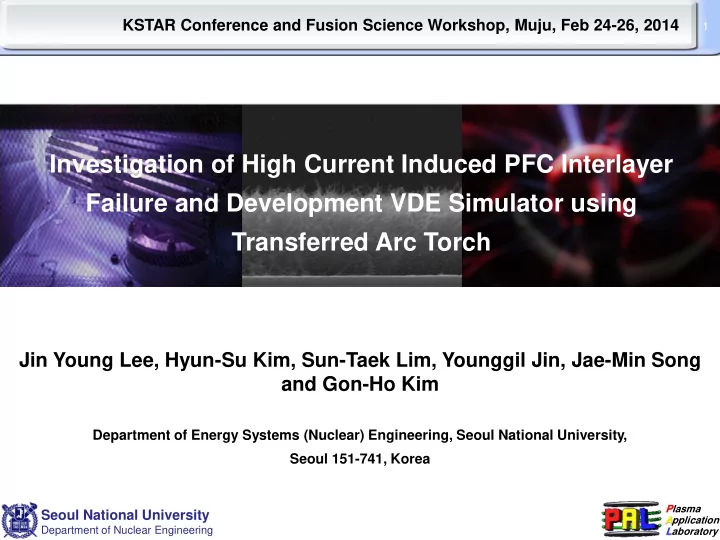

KSTAR Conference and Fusion Science Workshop, Muju, Feb 24-26, 2014 1 Investigation of High Current Induced PFC Interlayer Failure and Development VDE Simulator using Transferred Arc Torch Jin Young Lee, Hyun-Su Kim, Sun-Taek Lim, Younggil Jin, Jae-Min Song and Gon-Ho Kim Department of Energy Systems (Nuclear) Engineering, Seoul National University, Seoul 151-741, Korea Plasma Seoul National University Application Department of Nuclear Engineering Laboratory
Vertical Displacement Event in Tokamaks 2 [1] Thermal quenching [high heat flux] Current quenching [Halo current] J halo xB damage Runaway electron damage • Halo current at VDE - ITER : ~ 8 MA (limitation) - JET : ~ 3.5 MA - ASDEX : ~ 700 kA Heat flux : ~ GW/m 2 Current flux : 20 ~ 200 MA/m 2 During VDE Plasma Seoul National University Application Department of Nuclear Engineering [1] ITER physics expert group on disruption, Nucl. Fusion 39. 2251. (1999). Laboratory
Void Generation by High Current Flux on Heterogeneous Bond [2] 3 e e e e e e e Intermetallic compound Vacancy Void For CW current (Electric device, minor ELM) For Pulse current (major ELM, VDE) d d n n m 1 R n t J t J dt dt • Void relaxation factor d TTF c n t J t d t K MTTF R 0 0 DC MTTF pulse DC a 1 D a D 1 e 1 e D 1 a Time to failure (TTF) is a function of current flux, a D 1 e J(t) and background void character, R( δ ) Higher temperature, pulse duration in Tokamak case Plasma Seoul National University Application [2] J. Tao, et. Al., Phys. Symp., pp. 338-343. (1992), Department of Nuclear Engineering Laboratory
Interlayer Void Formation Effect on PFC Life Time 4 [3] [4] • IGBT bridge joint (~ MA/m 2 ), 180 o C • High current flux [> MA/m 2 ] enhance heterogeneous bond material diffusion intermetallic compound formation void generation • Void transient to interlayer crack by thermal stress at the heterogeneous bond vicinity Plasma Seoul National University [3] Miyazaki, T. et el., Microelectronics Reliablity, Vol. 46,pp. 1898-1903, (2006). Application [4] R. Mitteau, 5rd Karlsruhe International school on fusion technol. Department of Nuclear Engineering Laboratory
Experimental Setup for Simulate Current Quench on PFC 5 A 8000 Pulse current profile 6000 Current [A] 4000 W Cu 2000 W C 0 -0.50 -0.25 0.00 0.25 0.50 Time [msec] I Pulse high current ~ 10 kA ~ 200 μ sec (1/10 of current quench time) W Graphite Pulse I Current flux : 0.1, 1 GA/m2 Cycle : 100 cycle (10 cycle of VDE) Plasma Seoul National University Application Department of Nuclear Engineering Laboratory
Heterogeneous Bond Fracture by Current Quench : W-Graphite 6 Pristine 0.1 GA/m 2 1 GA/m 2 X 1k Graphite Graphite Titanium Titanium Graphite Tungsten Tungsten Titanium Tungsten • High current flux induced W-Ti-Graphite blazed specimen in room temperature condition • Bond material (Ti) diffusion is observed Plasma Seoul National University Application Department of Nuclear Engineering Laboratory
Heterogeneous Bond Fracture by Current Quench : W-Cu 7 0.1 GA/m 2 1 GA/m 2 Pristine X 1k X 5k • High current flux induced W-Cu blazed specimen in room temperature condition • Only current quenching condition of VDE is simulated and thermal quenching simulator development is in progress Plasma Seoul National University Application Department of Nuclear Engineering Laboratory
Transferred Arc Plasma Characteristics : SNU-PAL 8 Arc cathode Arc anode Arc operation current-power Anode spot : anode surface 70 60 Voltage [V] • Arc spot characteristic 50 ~ 300 A, 10 kW Heat flux : ~ 1 GW/m 2 - - Current flux : ~ 1 GA/m 2 40 transferred plasma method 30 60 80 100 120 140 Current [A] Plasma Seoul National University Application Department of Nuclear Engineering Laboratory
Thermal and Current Quench Simulator Development by Swept Arc Spot 9 Auxiliary pulse magnetic field Target Arc spot swept by auxiliary pulse B-field - ~ GW/m 2 , GA/m 2 spot sweep • Force balance for arc sweep ρ = 10 22 #/m 3 E = ~ 5x10 3 V/m ( ) F e E v B f E J B J = 10 9 A/m 2 F F To diffract 45 o , electric force Lorentz 19 22 3 3 1.6 10 C 10 #/ m 5 10 V / m E B 0.8 mTesla 80 G 9 2 J 10 A m / Required auxiliary B-field Plasma Seoul National University Application Department of Nuclear Engineering Laboratory
Design of Pulse Magnetic Field Coil for Arc swift 10 • Auxiliary magnetic field coil design 1 kA • Pulse magnetic field measurement 80 Pulse magnetic field B-dot probe 60 B-field [G] 40 20 0 Auxiliary coil -20 0 20 40 60 80 100 Plasma Seoul National University Time [ sec] Application Department of Nuclear Engineering Laboratory
Summary 11 • Current quench damage on PFC is simulate by pulse current source : 0.1, 1 GA/m 2 , 200 μ sec 100 cycle in room temperature condition to evaluate PFC damage on ITER VDE condition • Bond material (Ti) diffusion is observed in W-Ti-Graphite specimen and analysis the effect of electro-migration on material diffusion is in progress • In particular W-Cu intermetallic compound is not observed in 0.1, 1 GA/m 2 flux, 200 μ sec pulse 100 cycle in room temperature. • Thermal and current quench simulator development using transferred arc torch facility in progress - Auxiliary magnetic coil is designed and coil installation in transferred arc torch is in progress Plasma Seoul National University Application Department of Nuclear Engineering Laboratory
Recommend
More recommend